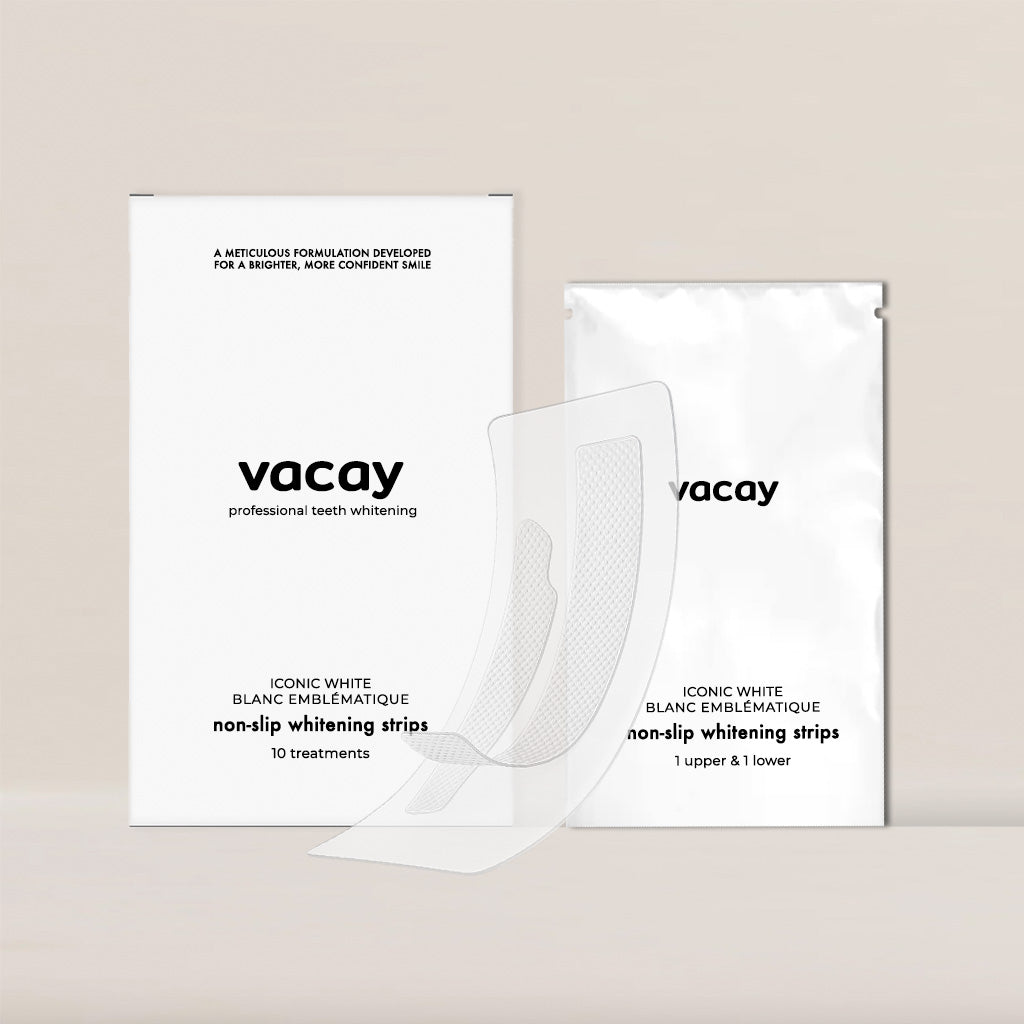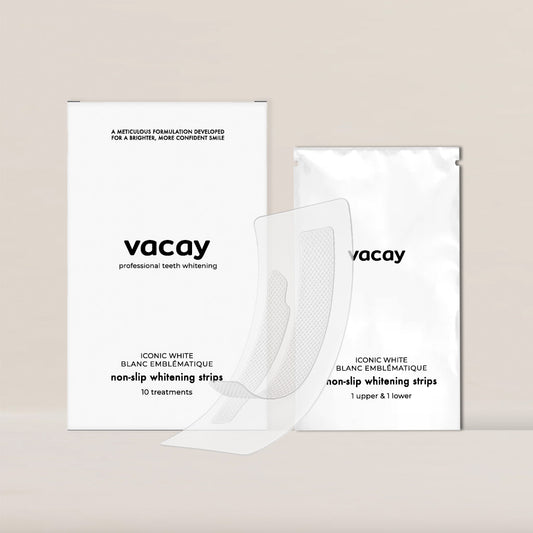
Are Teeth Whitening Strips Safe? Breaking Down the Ingredients
If you’ve ever wondered what exactly is happening when you pop on a whitening strip, you’re not alone. The idea of brightening your smile in 30 minutes flat sounds great—but is it actually safe?
The short answer: It depends on the strip. Not all whitening products are created with your enamel in mind. Many drugstore options can be harsh, overly abrasive, or loaded with ingredients that irritate gums and increase sensitivity. The active ingredient in most whitening strips is a bleaching agent such as hydrogen peroxide or carbamide peroxide, which is responsible for removing surface stains and achieving visible whitening results. Vacay is different.
Introduction to Teeth Whitening
Teeth whitening has become one of the most sought-after ways to achieve a brighter smile and boost confidence. Among the many teeth whitening products available, whitening strips stand out for their convenience and effectiveness. These thin, flexible strips are coated with a whitening gel—usually powered by hydrogen peroxide or carbamide peroxide, the active ingredients that help remove stains from your teeth. When applied as directed, whitening strips can lift years of discoloration caused by foods, drinks, and daily life.
The American Dental Association recognizes that, when used properly, whitening strips are a safe and effective way to whiten your teeth at home. So, if you’re looking to remove stains and freshen up your smile, whitening strips might just be your new go-to.
How Teeth Whitening Works
Ever wonder how whitening strips actually work their magic? It all comes down to powerful bleaching agents like hydrogen peroxide and carbamide peroxide. When you apply whitening strips to your teeth, these ingredients get to work by penetrating the tooth enamel and breaking apart the pigmented molecules—called chromogens—that cause stains. This process helps to lift surface stains from things like coffee, red wine, and tobacco, revealing a whiter, brighter smile underneath. The effectiveness of whitening strips depends on the strength of the bleaching agent, how long you leave the strips on, and the type of stains you’re targeting.
While whitening strips work wonders on surface stains, deeper discoloration may need professional whitening treatments for the best results. Either way, these strips are a simple, at-home solution for tackling everyday stains and brightening your teeth.
Intrinsic vs. Extrinsic Staining: What Are You Whitening?
Not all tooth stains are created equal. Tooth staining falls into two categories: extrinsic and intrinsic. Extrinsic stains are the ones you see on the outer surface of your teeth, often caused by foods and drinks like coffee, tea, or red wine, as well as tobacco products. These are the stains that whitening strips and most whitening products are designed to tackle, breaking down the discoloration and restoring your natural tooth color. Intrinsic staining, on the other hand, happens deeper inside the tooth and can be the result of aging, genetics, or certain medications.
While whitening strips can help with some mild intrinsic staining, more stubborn cases may require professional whitening treatments for noticeable results. Understanding the type of staining you have can help you choose the right whitening solution for your smile.
The Star: Hydrogen Peroxide
This is the main whitening agent used by both dentists and at-home products. Hydrogen peroxide works by breaking down stains on the surface and below the enamel, revealing a whiter smile.
Is it safe? Yes—in controlled doses. Vacay Whitening Strips use a clinically balanced level of hydrogen peroxide that’s strong enough to lift stains, yet gentle enough to avoid irritation. Hydrogen peroxide is one of the most commonly used bleaching agents in tooth whitening.
Some drugstore strips, however, can use unregulated or overly strong concentrations, which may lead to enamel damage or increased tooth sensitivity over time. Additionally, some whitening strips may contain chlorine dioxide, a chemical that can damage tooth enamel and increase dental risks if used improperly. It is best to avoid products with chlorine dioxide.
The Soother: Coconut Oil
This isn’t just for your smoothie. Coconut oil helps condition your teeth and gums during whitening. It has natural antibacterial properties and is known for its soothing, hydrating feel.
Why it matters: Whitening can be drying. Coconut oil adds that moisture back in, which helps keep sensitivity and gum irritation at bay—a step many conventional products skip entirely.
The Secret Sauce: VitalNourish™ Blend
Vacay's signature formula includes minerals and oils like sage oil that protect and strengthen tooth enamel while calming any potential inflammation.
Real talk: Whitening without protection is like sunbathing without SPF. VitalNourish™ is your built-in safety net, and it's something you're not getting from most whitening strips at the drugstore.
What We Don't Use:
- No SLS (a common irritant in toothpastes)
- No artificial dyes or sweeteners
- No parabens or animal products
Vacay is vegan, cruelty-free, and committed to clean teeth whitening products that actually do something.
Are Whitening Strips Suitable for Everyone?
While whitening strips are generally safe and effective for most people, they’re not a one-size-fits-all solution. If you have sensitive teeth, gum disease, or any enamel damage, it’s a good idea to check with your dentist before using whitening strips. The bleaching agents in these products can sometimes make sensitivity or gum irritation worse, especially if your teeth or gums are already compromised.
Whitening strips are also not recommended for children under 12, since their teeth are still developing, or for anyone who is pregnant or breastfeeding, as the effects of the ingredients haven’t been fully studied in these groups. Always follow the manufacturer’s instructions, and if you notice any increased sensitivity, gum irritation, or other issues while using whitening strips, stop and consult your dentist. Your comfort and dental health should always come first.
Maintaining Oral Hygiene During Whitening
Keeping your teeth healthy is just as important as making them whiter. While you’re using whitening strips, stick to a solid dental care routine: brush your teeth at least twice a day with fluoride toothpaste, and don’t forget to floss daily. This helps remove plaque and bacteria that could interfere with your whitening results.
To keep your smile looking its best, try to avoid foods and drinks that cause staining—like coffee, red wine, and tobacco products—especially during your whitening treatment. Regular dental check-ups are also key, as your dentist can monitor your progress and help address any sensitivity or side effects. By combining good oral hygiene with whitening strips, you’ll not only brighten your smile but also keep your teeth healthy and strong for the long run.
So, Are Whitening Strips Safe?
When they’re made with thoughtfulness and backed by real science—yes. Vacay teeth whitening strips are designed to give you dramatic results without compromising your enamel or comfort. For safe and effective use, it is important to follow the manufacturer's instructions and always read the product's packaging for detailed instructions and safety information.
But not all whitening strips are made the same. Some drugstore brands rely on outdated formulas, questionable additives, or one-size-fits-all ingredients that don’t account for sensitive teeth, gum health, or long-term enamel strength. Leaving whitening strips on for longer than recommended can increase the risk of tooth sensitivity and irritation, especially if the product comes into contact with gum tissue due to improper application. The most common side effect of whitening strips is tooth sensitivity.
Teeth whitening strips safe?
When it’s Vacay, absolutely. Just follow the product instructions, avoid tobacco products, and steer clear of foods and drinks that stain, like red wine or certain foods high in pigment. Whitening strips are a type of teeth whitening product, and it’s important to use whitening strips as directed for safety.
Some other tooth whitening options use carbamide peroxide, which breaks down into hydrogen peroxide over time, but can be harsher on sensitive teeth. Vacay is formulated for comfort—so you won’t have to worry about increased tooth sensitivity or discomfort from hot or cold foods.
Whitening strips are effective at removing stains caused by foods, drinks, and tobacco. Remember: most whitening strips should only be used on natural teeth, and it’s best to avoid leaving whitening strips on longer than the manufacturer’s instructions recommend. Whitening strips should only be left on the teeth shortly, typically about 30 minutes, as indicated in the instructions.
They are designed to be applied to both the upper and lower teeth for comprehensive whitening. The lower teeth are often overlooked but should be included for even results. Overuse can lead to tooth sensitivity or gum irritation.
Are teeth whitening strips safe?
When used properly—and especially when formulated like Vacay’s—whitening strips may whiten teeth by a few shades, though results vary. They’re generally safe and effective. You’ll start noticing results in a few days, especially in removing surface stains and evening out tooth color.
Brushing with whitening toothpaste or baking soda can help maintain results between whitening treatments. In office procedures performed by a dentist can provide more dramatic whitening results for stubborn stains. However, improper use of whitening products can increase the risk of tooth decay.
No dentist visit. No sensitivity. Just a confident, radiant smile.
Ready to whiten your teeth the clean, enamel-safe way? Grab your Vacay Strips or Pen and let the glow-up begin. Your brighter smile is just a few strips away.




